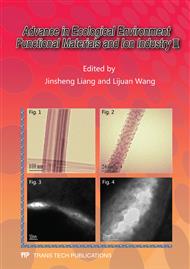p.3
p.7
p.13
p.19
p.26
p.32
p.38
p.45
p.51
Diopside-Based Glass-Ceramics from Chrysotile Asbestos Tailing
Abstract:
By utilizing chrysotile asbestos tailing from Shannan ore in Sichuan as the main raw material, diopside-based glass-ceramics were successfully synthesized in the laboratory by adding some limestone, quartz sand, Al2O3, H3BO3, Na2CO3 and CaF2. The optimum procedure for glass-ceramics was as follows: melting at 1400 for 60 min, sintering at 1100 for 120 min. Through the tests of physical and mechanical properties, the glass-ceramics materials with more crystalline phase had high density, fine performance of resisting compression (366MPa) and negligible water absorption. Through chemical resistance tests, the glass-ceramics samples showed strong corrosion resistance. Overall result indicated that it was a feasible attempt to produce glass-ceramics materials for building and decorative materials from chrysotile asbestos tailing.
Info:
Periodical:
Pages:
26-31
Citation:
Online since:
January 2012
Authors:
Price:
Сopyright:
© 2012 Trans Tech Publications Ltd. All Rights Reserved
Share:
Citation:


